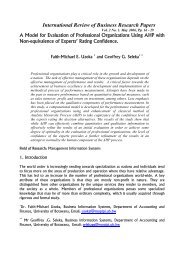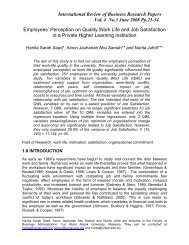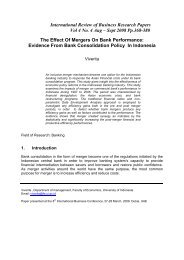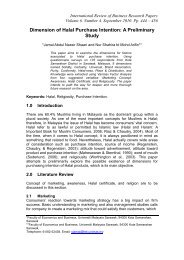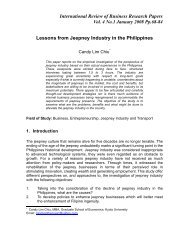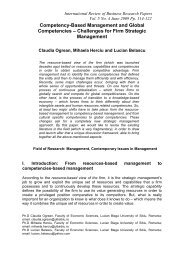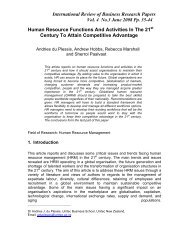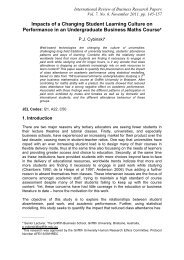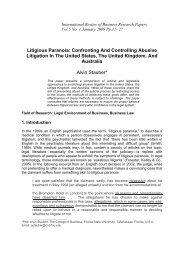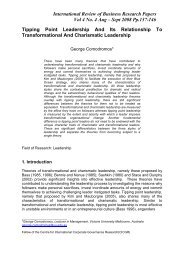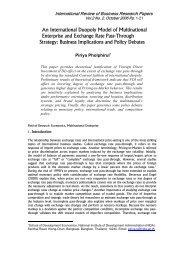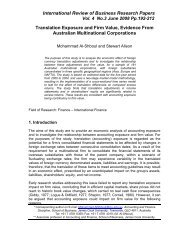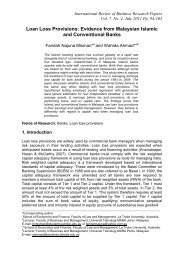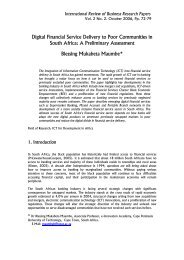The Effect of Sourcing Strategies on the Relationship Between ...
The Effect of Sourcing Strategies on the Relationship Between ...
The Effect of Sourcing Strategies on the Relationship Between ...
You also want an ePaper? Increase the reach of your titles
YUMPU automatically turns print PDFs into web optimized ePapers that Google loves.
Abdullah, Mohamed, Othman & Ulibargaining power (Porter, 1980; Malburg, 2000; Venu, 2001; Davids<strong>on</strong>, 2001;Allen et al., 2006).. <str<strong>on</strong>g>The</str<strong>on</strong>g> basic idea is to underprice competitors and <strong>the</strong>reby gainmarket share and sales, driving some competitors out <str<strong>on</strong>g>of</str<strong>on</strong>g> <strong>the</strong> market entirely(Porter, 1980).2.1.1.2 Differentiati<strong>on</strong>Firms that adopt a differentiati<strong>on</strong> strategy seek to establish fundamentaldifferences in a variety <str<strong>on</strong>g>of</str<strong>on</strong>g> dimensi<strong>on</strong>s so that buyers perceive a marked c<strong>on</strong>trastbetween <strong>the</strong> products <str<strong>on</strong>g>of</str<strong>on</strong>g> <strong>on</strong>e firm and its rivals. A firm focuses <strong>on</strong> providing aunique product or service (Porter, 1980; Cross, 1999; Hyatt, 2001; Bauer &Colgan, 2001; Hlavacka et al., 2001). Successful differentiati<strong>on</strong> can mean greaterproduct flexibility, greater compatibility, and more features (Porter, 1980;Davids<strong>on</strong>, 2001; McCracken, 2002; Allen et al., 2006). Differentiati<strong>on</strong> yields highmargins with which to deal with supplier power and clearly mitigates buyer powersince buyers lack comparable alternatives and are <strong>the</strong>reby allows a firm tocharge a higher price for its products (Porter, 1980; Venu, 2001; Hlavacka et al.,2001).2.1.2 <str<strong>on</strong>g>Sourcing</str<strong>on</strong>g> strategiesCapr<strong>on</strong> and Mitchell (2004) define make as when a firm recombine its existingresources or developing new resources <strong>on</strong> its own; and buy as when a firm tradeits activities that held in a strategic capability which stems from external sources.<str<strong>on</strong>g>The</str<strong>on</strong>g> sourcing decisi<strong>on</strong> can <str<strong>on</strong>g>of</str<strong>on</strong>g>ten be a major determinant <str<strong>on</strong>g>of</str<strong>on</strong>g> pr<str<strong>on</strong>g>of</str<strong>on</strong>g>itability, making asignificant c<strong>on</strong>tributi<strong>on</strong> to <strong>the</strong> financial health <str<strong>on</strong>g>of</str<strong>on</strong>g> <strong>the</strong> firm (Yo<strong>on</strong> & Naadimuthu,1994; McIvor et al., 1997). <str<strong>on</strong>g>The</str<strong>on</strong>g> sourcing strategy espoused by a firm may focus<strong>on</strong> cost leadership, differentiati<strong>on</strong>, or o<strong>the</strong>r intents which form <strong>the</strong> basis <str<strong>on</strong>g>of</str<strong>on</strong>g> <strong>the</strong>competitive edge (Porter, 1980). One <str<strong>on</strong>g>of</str<strong>on</strong>g> <strong>the</strong> distinguishing attributes <str<strong>on</strong>g>of</str<strong>on</strong>g> effectivesourcing strategy is that, it plays an integrative role in <strong>the</strong> firm’s strategic planningprocess (Reck & L<strong>on</strong>g, 1988, Ammer, 1989; Carr et al., 2000; Carr & Pears<strong>on</strong>,2002); and <strong>the</strong> key to succeed in achieving such integrati<strong>on</strong> lies in <strong>the</strong> skills andcapabilities <str<strong>on</strong>g>of</str<strong>on</strong>g> <strong>the</strong> people who work in <strong>the</strong> purchasing functi<strong>on</strong> (Reck & L<strong>on</strong>g,1988; Carr & Pears<strong>on</strong>, 2002).2.1.2.1 Make StrategyFirms may opt for make strategy when targeted capabilities do not exist outside<strong>the</strong> firm or even if <strong>the</strong>y do exist, <strong>the</strong>y cannot be traded through markets or acrossfirms (Capr<strong>on</strong> & Mitchell, 2004), or when suppliers do not want to trade uniqueand valuable resources (Dierickx & Cool, 1989). To remain competitive, firmsneed to develop <strong>the</strong> ability to recombine its internal capabilities into newc<strong>on</strong>figurati<strong>on</strong>s <str<strong>on</strong>g>of</str<strong>on</strong>g> capabilities (Henders<strong>on</strong> & Clark, 1990; Galunic & Rodan, 1998).349



